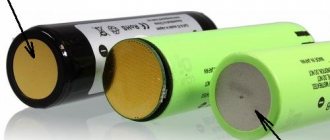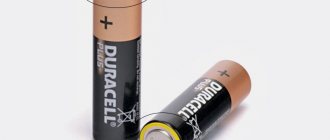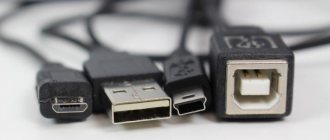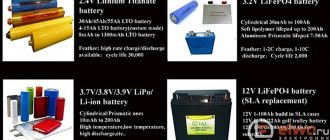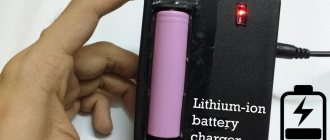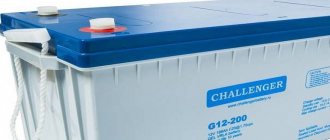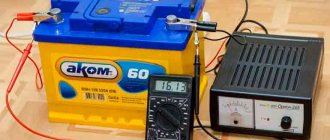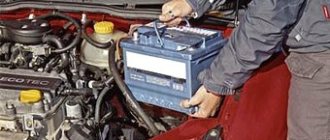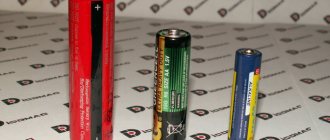Smartphones, laptops, hand-held power tools, LED flashlights are just a small list of wireless devices that require an energy source - batteries or accumulators - for uninterrupted operation. The most popular format is Li Ion battery 18650. The functionality and service life of the power source depends on how correctly it is used. How charging is carried out for 18650 batteries, what chargers are used, and what current parameters to set - this is discussed in the article.
To properly charge a 18650 battery, you need to select the appropriate charger and charging parameters.
How to charge a 18650 battery
18650 is typically a lithium ion power source for flashlights, electronic cigarettes, and other devices. Dimensions: height – 65 mm, diameter – 18 mm. The inside of the battery is equipped with metal electrodes - lithium ions circulate between them, thereby generating electric current. A high charge or discharge leads to the accumulation of more ions on one electrode, they “build up”, which entails a decrease in the performance characteristics of the element.
Charging 18650 should be carried out in compliance with the general rules:
- ambient temperature range – from +10 to +40°;
- To prevent the battery from overheating as the charge is replenished, it is allowed to temporarily disconnect the charger from the network (this is not necessary if the charger is equipped with a built-in thermistor);
- even if the battery is new, it is recommended to first charge it and check it with a multimeter before installing it in an electrical device;
- The battery must be charged when it is dead. Then self-discharge will occur, and if the voltage drops significantly, the power source will fail;
- You should not leave the battery in the charger for a long time after it has restored its charge - for a maximum of 20 - 30 minutes.
It is worth mentioning that there are series and parallel connected batteries, and in each case a number of features must be taken into account.
Series battery connection
Serial connection of the battery.
With this connection, the voltage of all batteries is summed up. If you connect a load, each battery will supply a current equal to the total current in the network. It turns out that the discharge current sets the load resistance. As for the capacity, with this assembly it is equal to the capacity of the power source with the lowest energy intensity.
If all batteries have a maximum charge, that is, 100%, the discharge current will be the same everywhere. The battery with the lowest capacity will run out first. When it is discharged, the assembly will no longer be able to be loaded, despite the fact that the remaining batteries still have charge. If you continue to remove current, the “weak” battery will begin to overcharge and quickly deteriorate. It is for this reason that the capacity of the assembly is equal to the capacity of the lowest-capacity, or most discharged, battery.
We can draw the following conclusion: when sequentially assembled, batteries of the same capacity are needed, and they all must be charged 100%. There is such a system as BMS (Battery Monitoring System), which tracks each battery in the bundle. As soon as one element is discharged, the entire assembly is disconnected from the load.
As for charging itself, they set the voltage to be equal to the sum of the maximum voltages on all batteries. In the case of lithium power supplies, this is 4.2 V. That is, if there are three batteries in the assembly, the parameter is 12.6 V.
It is important that the energy intensity of all elements is the same. If not, one battery will recover faster than the others, and while it waits for the end, it will begin to warm up and recharge. And recharging for lithium is critical.
Parallel battery connection
The peculiarity of the connection is that the capacity of the batteries included in the bundle is summed up. The discharge current for each is equal to the total load current divided by the number of elements. It turns out that more batteries in a bundle means it can deliver more current. As for tension, there is one point. If the assembly contains batteries with different voltages (charged to a certain percentage), then when connected they will begin to exchange energy, and as a result, the voltage will equalize for all.
Parallel battery connection.
Before making a parallel connection, it is recommended to charge the elements equally, otherwise, due to high currents, the most discharged will go to the battery. At the same time, it is allowed that the energy intensity of the power sources be different - the one that is “stronger” will not allow the “weaker” one to discharge faster. There are no problems when charging either - the assembly is automatically balanced.
Ability to work with batteries of different formats and sizes
- Functional chargers for lithium-ion batteries 18650 are capable of charging finger-type cells of various form factors. They have a movable plus/minus contact that allows each slot in the charger to adjust to the length of the battery. Thanks to the mobile contact, one charger is suitable for charging almost all types of lithium-ion batteries, and you do not need to buy a new charger for each format separately. All charges of this type have automatic control and an automatic shutdown system when the maximum charge level is reached.
- Users positively characterize smart chargers that allow them to independently set the charging and discharging voltage of batteries, speed up, measure and restore battery capacity. Such a smart device is more expensive. The smart system does not require setting up the device, but determines the charge level, speed, time, voltage automatically when the battery is inserted. These functions are especially important for high-quality fast charging, saving energy, and preserving battery life.
Smart charger for 4 batteries
- If there is a need to charge many batteries at the same time, using the most popular chargers for four batteries in this case is inconvenient, uses a lot of time and requires additional attention. Using several chargers at once may also be an irrational solution to this problem. To simultaneously charge a large number of batteries, there is a multi-channel charger for AA batteries, which allows you to charge up to sixteen units.
Charging options
Both in series and parallel connections, the charging and discharging currents must be observed. If the battery is lithium, the charging current should not be more than half the energy capacity, measured in Amperes. For example, a 1000 mAh model (1 Ah) - the current is set to 0.5 A; 2 Ah – 1 A.
The maximum discharge currents are indicated in the battery characteristics. Many models for smartphones and laptops do not allow currents that are twice the energy capacity of the battery. Let's say the battery is 2500 mAh, the limit for it is 5 A (2.5 x 2). However, high-current devices are now being produced.
Marking of lithium batteries 18650
There are markings on the surface of the battery case. Here you can find complete information about the technical properties. In addition to the manufacturing date, expiration date and manufacturer's brand, the device of 18650 lithium batteries and the consumer qualities associated with this aspect are encrypted.
- ICR – lithium-cobalt cathode. The battery has a high capacity, but is designed for low current consumption. Used in laptops, video cameras and similar long-lasting equipment with low energy consumption.
- IMR – lithium manganese cathode. It has the ability to produce high currents and can withstand discharge up to 2.5 a/h.
- INR – nickelate cathode. Provides high currents, withstands discharge up to 2.5 V.
- NCR is a specific marking of Panasonic. The properties of the battery are identical to the IMR. Nickelates, cobalt salts, and aluminum oxide are used.
Positions 2,3,4 are called “high-current”, they are used for flashlights, binoculars, and cameras.
Lithium ferrophosphate batteries have the ability to operate at deep minus temperatures and are restored during deep discharge. Undervalued on the market.
By the marking you can determine whether this is a rechargeable lithium battery with the letters I R. If there are letters C/M/F, the cathode material is known. The capacity indicated will be mA/h. The release date and expiration date are located in different places.
You should know that manufacturers of rechargeable lithium batteries do not have products with a capacity of more than 3,600 mAh. In order to repair a laptop battery or assemble a new one, you need to purchase batteries without protection. To use a single copy, you need to buy elements with protection.
Selecting a charger
The chargers presented on store shelves differ in operating parameters and functionality:
Universal memory.
- simple. Charger with one socket, delivering a maximum current of 1 A;
- improved. There are two sockets, the maximum voltage is 4.2 V. A more expensive, but convenient option, as it is equipped with an indication;
- universal. Suitable for charging any batteries with different chemistry.
There are enough chargers, and the more expensive the model, the more reliable it is (with indicators, security systems).
If you wish and if time permits, you can assemble the charger with your own hands, but you will need the ability to solder and “read” circuits.
Which company should you choose?
All experts agree that you should not save on purchasing a high-quality and reliable battery charger; it is better to choose a suitable model among the products of such popular brands as LiitoKala, Duracell, GP, Energizer, Panasonic, Varta and Technoline, which are characterized by optimal combination of price and quality.
Among budget models, it is worth giving preference to the brands Camelion, Philips, PowerPlant, but products from the Apple and Sony brands, of course, will delight their owners with excellent quality, but the price will also be significantly higher than that of analogues produced by other brands.
Manufacturers rating
There are many companies involved in the production of power supplies, and it would be wrong to use such a descriptive characteristic as “the best”. Here is a rating of models that have proven themselves to be reliable and durable:
Samsung INR18650-25R.
- Samsung ICR18650. Capacity – 2600 mAh, available, but without a protection system. Often counterfeited;
- LG 18650 HE2. The capacity is 2500 mAh, capable of delivering a current of 20 A. The battery practically does not drain completely due to the chemical composition - Hybrid IMR. Therefore, it is in demand for powering electronic cigarettes (vapes);
- Samsung INR18650-25R. Capacity – 2500 mAh, used for powerful devices where various loads are expected. The discharge current parameter is 20 – 100 A;
- Panasonic NCR18650B. Energy capacity – 3400 mAh, discharge current – 1.6 – 6 A. Service life – approximately 300 cycles;
- Robiton 18650-3000. Battery with discharge and overcharge protection, capacity 3000 mAh and discharge current 3.5 A.
Other popular models worth highlighting are: Samsung ICR18650-26HM, Olight 18650 ORB-186P36, ANSMANN Li-Ion 18650, Sony 18650 VTC5.
Marking of lithium batteries 18650
There are markings on the surface of the battery case. Here you can find complete information about the technical properties. In addition to the manufacturing date, expiration date and manufacturer's brand, the device of 18650 lithium batteries and the consumer qualities associated with this aspect are encrypted.
- ICR – lithium-cobalt cathode. The battery has a high capacity, but is designed for low current consumption. Used in laptops, video cameras and similar long-lasting equipment with low energy consumption.
- IMR – lithium manganese cathode. It has the ability to produce high currents and can withstand discharge up to 2.5 a/h.
- INR – nickelate cathode. Provides high currents, withstands discharge up to 2.5 V.
- NCR is a specific marking of Panasonic. The properties of the battery are identical to the IMR. Nickelates, cobalt salts, and aluminum oxide are used.
Positions 2,3,4 are called “high-current”, they are used for flashlights, binoculars, and cameras.
Lithium ferrophosphate batteries have the ability to operate at deep minus temperatures and are restored during deep discharge. Undervalued on the market.
By the marking you can determine whether this is a rechargeable lithium battery with the letters I R. If there are letters C/M/F, the cathode material is known. The capacity indicated will be mA/h. The release date and expiration date are located in different places.
You should know that manufacturers of rechargeable lithium batteries do not have products with a capacity of more than 3,600 mAh. In order to repair a laptop battery or assemble a new one, you need to purchase batteries without protection. To use a single copy, you need to buy elements with protection.
